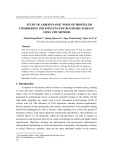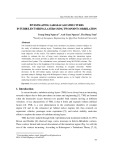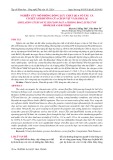
REGULAR ARTICLE
Sensitivity and uncertainty analysis of b
eff
for MYRRHA using
a Monte Carlo technique
Hiroki Iwamoto
1,2,*
, Alexey Stakovskiy
1
, Luca Fiorito
1,3
, and Gert Van den Eynde
1
1
Institute for Advanced Nuclear Systems, Belgian Nuclear Research Centre (SCK·CEN), Boeretang 200, 2400 Mol, Belgium
2
J-PARC Center, Japan Atomic Energy Agency (JAEA), 2-4, Shirakata, Tokai-mura, Naka-gun, Ibaraki 319-1195, Japan
3
Data Bank, OECD Nuclear Energy Agency (NEA), 46, Quai Alphonse Le Gallo 92100 Boulogne-Billancourt, France
Received: 3 October 2017 / Received in final form: 26 January 2018 / Accepted: 14 May 2018
Abstract. This paper presents a nuclear data sensitivity and uncertainty analysis of the effective delayed
neutron fraction b
eff
for critical and subcritical cores of the MYRRHA reactor using the continuous-energy
Monte Carlo N-Particle transport code MCNP. The b
eff
sensitivities are calculated by the modified k-ratio
method proposed by Chiba. Comparing the b
eff
sensitivities obtained with different scaling factors aintroduced
by Chiba shows that a value of a= 20 is the most suitable for the uncertainty quantification of b
eff
. Using the
calculated b
eff
sensitivities and the JENDL-4.0u covariance data, the b
eff
uncertainties for the critical and
subcritical cores are determined to be 2.2 ± 0.2% and 2.0 ± 0.2%, respectively, which are dominated by delayed
neutron yield of
239
Pu and
238
U.
1 Introduction
To promote research and development of nuclear technol-
ogy for various applications such as accelerator-driven
systems, the Generation-IV reactors, and production of
medical radioisotopes, the Belgian Nuclear Research
Centre (SCK·CEN) has proposed a cutting-edge research
reactor combined with a proton accelerator, MYRRHA
[1,2]. From the viewpoint of ensuring safety margins and
reducing uncertainty in the MYRRHA design parameters,
uncertainty quantification of reactor physics parameters is
one of the most important tasks. To this end, nuclear data
sensitivity and uncertainty (S/U) analyses have been
extensively conducted for various MYRRHA core config-
urations using different calculation tools, geometric
models, and nuclear data libraries [3–5]; these works have
focused on the effective neutron multiplication factor k
eff
as
the primary neutronic safety parameter. The effective
delayed neutron fraction b
eff
can be ranked second in the
list of neutronic safety parameters, because, besides of
reactor kinetics, it is used to determine other design and
safety parameters such as control rod worth and Doppler
coefficient.
Continuous-energy Monte Carlo transport codes such
as the Monte Carlo N-Particle transport code MCNP [6]
have been widely used in calculating not only k
eff
but also
its nuclear data sensitivities and kinetic parameters
including b
eff
. Although these codes have no capability
to directly calculate the b
eff
sensitivities owing to technical
cumbersomeness, it is approximately expressed as a
function of two different k
eff
sensitivities by the so-called
“k-ratio method [7]”; this indicates that uncertainty in b
eff
can be quantified by the sensitivity method from the
approximate b
eff
sensitivities and evaluated covariance
data of the nuclear data library. Although this method has
been applied to the b
eff
S/U analysis with a deterministic
code SUSD3D for MYRRHA in the studies of Kodeli [8],
within the seventh framework programme solving CHAl-
lenges in Nuclear DAta (CHANDA) project [9], the
analysis using the Monte Carlo transport code has not
yet been tackled.
The k-ratio method itself is currently subdivided into
two techniques: the prompt k-ratio method [7] and the
modified k-ratio method proposed by Chiba [10,11]. Our
previous study [12] by MCNP for a critical configuration of
the VENUS-F zero-power reactor at the SCK·CEN site [13]
demonstrated that the prompt k-ratio method involves
large statistical uncertainty in the calculated b
eff
sensitivi-
ties, and it would be currently difficult to reduce it only by
increasing the number of neutron source histories. On the
other hand, we also demonstrated that Chiba’s modified k-
ratio method can alleviate this kind of problem.
In this study, we conducted the S/U analysis of b
eff
for
two types of MYRRHA configurations (i.e. critical mode
and subcritical mode) using Chiba’s modified k-ratio
method. b
eff
and its sensitivities were calculated using
*e-mail: iwamoto.hiroki@jaea.go.jp
EPJ Nuclear Sci. Technol. 4, 42 (2018)
©H. Iwamoto et al., published by EDP Sciences, 2018
https://doi.org/10.1051/epjn/2018023
Nuclear
Sciences
& Technologies
Available online at:
https://www.epj-n.org
This is an Open Access article distributed under the terms of the Creative Commons Attribution License (http://creativecommons.org/licenses/by/4.0),
which permits unrestricted use, distribution, and reproduction in any medium, provided the original work is properly cited.

the MCNP version 6.1.1, and JENDL-4.0u [14,15] was used
as the nuclear data library since it contains covariance data
of delayed neutron yield nd.
2 MYRRHA core models
MYRRHA is designed to operate both in critical mode as a
lead-bismuth cooled fast reactor and in subcritical mode
driven by 600-MeV linear proton accelerator. Figures 1 and
2show horizontal sectional views of the MYRRHA critical
and subcritical configurations, respectively, which are
homogenized on assembly level. The analyses were carried
out for the critical and subcritical core configurations at
beginning of cycle using the assembly-based homogenized
models [16]. As illustrated, the critical and subcritical cores
consist of 78 and 58 fuel assemblies (FAs), respectively;
these are loaded with MOX with high Pu content. Besides
FAs, the cores contains in-pile sections for material testing,
irradiation rigs for medical isotope production, and
subassemblies containing safety and control rods. More
details of the MYRRHA core design are given in Van den
Eynde et al. [2].
3 Methodology
3.1 The b
eff
sensitivities
Chiba’s modified k-ratio method describes b
eff
as
beff ≃k
k1
⋅1
a;ð1Þ
where a(≠0) is a scaling factor; kis the effective
multiplication factor calculated using the nuclear data
library JENDL-4.0u; kis the effective multiplication factor
calculated using the library in which ndis multiplied with
(a+1) (Appendix A). If a=1, then Chiba’s modified k-
ratio method reduces to the prompt k-ratio method. The
statistical uncertainty in b
eff
propagated from dkand dkis
expressed as follows:
dbeff ¼k
kffiffiffiffiffiffiffiffiffiffiffiffiffiffiffiffiffiffiffiffiffiffiffiffiffiffiffiffiffiffiffiffiffi
dk
k
2
þdk
k
2
s⋅1
jaj:ð2Þ
Here correlations were disregarded for the sake of
simplicity. Using the definition of the sensitivity and
equation (1), the b
eff
sensitivity to parameter xis expressed
as follows:
Sbeff
x≡∂beff
∂x
x
beff
;ð3Þ
≃k
kkSk
xSk
x
;ð4Þ
where Sk
xð≡ð∂k=∂xÞ=ðx=kÞÞ and Sk
xð≡ð∂k=∂xÞ=ðx=kÞÞ are
the sensitivities of kand kto the parameter x, respectively.
The statistical uncertainty in Sbeff
xis expressed as
dSbeff
x≃jSbeff
xj⋅dk
k
2
þdk
2þdkðÞ
2
kk
2þ
dSk
x
2þdSk
x
2
Sk
xSk
x
2
8
>
<
>
:
9
>
=
>
;
1=2
;
ð5Þ
where dSk
xand dSk
xare the statistical uncertainties in Sk
x
and Sk
x, respectively.
3.2 The b
eff
uncertainties
Using the sensitivity profile obtained by the above-
mentioned methods, the b
eff
uncertainty (standard devia-
tion) due to nuclear data was evaluated by the uncertainty
propagation law considering covariance, which is expressed
as
Ubeff ¼ffiffiffiffiffiffiffiffiffiffiffiffiffiffiffiffiffiffiffiffiffiffiffiffiffiffiffiffiffiffiffiffiffiffiffiffiffiffiffiffiffiffiffiffiffiffiffiffiffiffiffiffiffiffiffiffiffiffiffiffiffiffiffiffiffiffiffiffiffiffiffiffiffiffiffi
X
zX
z0X
gX
g0
Sbeff
z;gcov z;g;z0;g0
ðÞSbeff
z0;g0
s;ð6Þ
where cov(z,g;z
0
,g
0
) denotes a (g,g
0
;z,z
0
) component of
variance–covariance matrix (g,g
0
: energy group, z,z
0
:
reaction), which was obtained by processing covariance
data stored in JENDL-4.0u with NJOY [17] and ERRORJ
[18]. In this analysis, we employed eight parameters: fission,
neutron capture, elastic scattering, inelastic scattering, and
(n,2n) reaction cross sections for major constituent
materials: U, Pu,
241
Am,
16
O,
56
Fe, Pb, and
209
Bi, as well
as prompt and delayed neutron yields and prompt neutron
spectra for U and Pu isotopes. Here correlations between the
reactions were also considered. Absence of covariance data
for delayed neutron spectrum in JENDL-4.0u did not allow
us to estimate the contribution to the b
eff
and confirm the
conclusion made by Kodeli [19] on its significance.
Fig. 1. Horizontal sectional view of MYRRHA critical core.
2 H. Iwamoto et al.: EPJ Nuclear Sci. Technol. 4, 42 (2018)

4 Results and discussion
4.1 Effective delayed neutron fraction
Figure 3 shows comparisons of the calculated b
eff
with
different scaling factors (a=1, 1, 5, 10, 15, 20, and 25) for
critical and subcritical cores. For each case, the k
eff
value
was calculated with 2.5 10
8
histories (2.5 10
5
source
histories per cycle times 10
3
cycles) in the MCNP
calculation flow. Here the value calculated directly by
the adjoint weighting method [20] for the same number of
histories for critical and subcritical cores were estimated to
be 323 ± 4 and 320 ± 4 pcm, respectively. It can be seen
that the calculated statistical uncertainty decreases with
increase in a, which was about |a| times smaller than that
by the prompt kratio method (a=1). In addition, we see
that the calculated b
eff
values exceeding their 1sstatistical
uncertainties decrease as aincreases. The similar trend can
be seen in the previous study conducted for the VENUS-F
reactor using MCNP [12] and the benchmark analysis for
fast neutron systems conducted by Chiba using the
deterministic transport code CBG [10,21]; this reason is
linked to the approximation used in equation (1).
4.2 Sensitivity
Figures 4 and 5show comparisons of the b
eff
sensitivity
profiles of
239
Pu fission and elastic scattering cross sections
and
239
Pu npand ndfor the critical core with different
scaling factors, respectively. As demonstrated in Iwamoto
et al. [12], the statistical uncertainty at a= 1 is very large
for all parameters except nd; this is caused by the small
difference between Sk
xand Sk
x(Appendix A). In contrast,
the statistical uncertainty for ndis negligibly small for all
the selected avalues; this is owing to an approximation of
Sk
nd≃ðaþ1ÞSk
nd(Appendix A). In addition, as with
the b
eff
values, dSbeff
xdecrease as aincreases. However, it
should be noted that the b
eff
sensitivities change within
about 1sstatistical uncertainties, while the nominal values
of b
eff
tend to exceed their 1sstatistical uncertainties. This
indicates that the influence of the change in the b
eff
sensitivities that results from increasing aon the
uncertainty quantification of b
eff
is expected to be small.
Figures 6 and 7show the b
eff
sensitivity profiles with
respect to
239
Pu and
238
U reaction parameters for the
critical core with a= 20, respectively, in which the
statistical uncertainties appear to be sufficiently small.
Table 1 summarizes the major b
eff
sensitivities together
with 1sstatistical uncertainties which were calculated with
a= 20. As expected from the definition of b
eff
,ndof major
Fig. 2. Horizontal sectional view of MYRRHA subcritical core.
Fig. 3. Comparison of the b
eff
values for different scaling factors
calculated using Chiba’s modified k-ratio method and that
derived using the adjoint weighting method. The error bars and
the band with pale blue color indicate 1sstatistical uncertainty.
Fig. 4. Comparisons of b
eff
sensitivity profile of
239
Pu fission
(left) and elastic scattering (right) cross sections for the critical
core with different scaling factors. The pale blue color around the
blue line indicates 1sstatistical uncertainty.
H. Iwamoto et al.: EPJ Nuclear Sci. Technol. 4, 42 (2018) 3

fuel materials (i.e.
239
Pu and
238
U) shows positive high
sensitivities; in contrast, npdemonstrates negative sensi-
tivities.
4.3 Uncertainty
Table 2 lists the b
eff
uncertainties due to nuclear data with
different scaling factors for the critical and subcritical
cores. Small scaling factors produce large both uncertainty
values and their statistical uncertainties. This arises from
the large sensitivities with large statistical uncertainties in
the sensitivity profile as mentioned above; these statistical
uncertainties can be reduced by increasing a. In addition,
we see from Table 2 that, as aincreases, the calculated
total b
eff
uncertainties for the critical and subcritical cores
approach values of 2.2% and 2.0%, respectively.
Table 3 summarizes top 15 contributors to the b
eff
uncertainty together with 1sstatistical uncertainties.
Overall, the statistical uncertainties are small enough to
identify the main contributors; namely, it can be concluded
that the b
eff
uncertainty is dominated by nd, followed by
the elastic and inelastic scattering cross sections, for both
cores.
5 Conclusion
We have conducted the nuclear data S/U analysis of b
eff
for
critical and subcritical cores of the MYRRHA reactor using
the MCNP code. The b
eff
sensitivities were calculated by
Chiba’s modified k-ratio method. Although the nominal
b
eff
values appear to worsen as aincreases, comparing
the b
eff
sensitivities and their statistical uncertainties
calculated with different scaling factors shows that the b
eff
sensitivities are more stable to the achange than the
nominal b
eff
values, and that a value of a= 20 is the most
suitable for the uncertainty quantification. Using the
calculated b
eff
sensitivities and the JENDL-4.0u covari-
ance data, the b
eff
uncertainties for the critical and
subcritical cores have been determined to be 2.2 ± 0.2%
and 2.0 ± 0.2%, respectively, which are dominated by ndof
239
Pu and
238
U.
To account for the optimal avalue more clearly,
further investigation, especially for non-linear effects on
caand c†
a, is needed. Moreover, it would be of interest to
compare our results with those previously performed using
the deterministic code within the ongoing CHANDA
project [8].
Fig. 5. Comparisons of b
eff
sensitivity profile of
239
Pu np(left)
and nd(right) for the critical core with different scaling factors.
The pale blue color around the blue line indicates 1sstatistical
uncertainty.
Fig. 6.
239
Pu sensitivity profile for the critical core (a= 20).
Fig. 7.
238
U sensitivity profile for the critical core (a= 20).
4 H. Iwamoto et al.: EPJ Nuclear Sci. Technol. 4, 42 (2018)

Table 1. Major b
eff
sensitivities with 1sstatistical uncertainities (a= 20, top 15).
Nuclide Reaction Sensitivity (%/%)
Critical core Subcritical core
239
Pu np0.589 ± 0.013 0.520 ± 0.011
239
Pu nd0.409 ± 0.001 0.362 ± 0.001
238
Und0.303 ± 0.001 0.277 ± 0.001
238
U Fission 0.195 ± 0.003 0.175 ± 0.003
239
Pu Fission 0.154 ± 0.013 0.140 ± 0.012
241
Pu nd0.136 ± 0.000 0.119 ± 0.000
238
Unp0.128 ± 0.003 0.119 ± 0.002
240
Pu np0.114 ± 0.002 0.105 ± 0.002
241
Pu Fission 0.070 ± 0.002 0.060 ± 0.002
241
Pu np0.067 ± 0.002 0.057 ± 0.002
240
Pu nd0.063 ± 0.000 0.057 ± 0.000
238
U Elastic 0.049 ± 0.037 0.006 ± 0.032
56
Fe Elastic 0.037 ± 0.037 0.058 ± 0.032
240
Pu Fission 0.036 ± 0.002 0.035 ± 0.002
238
U Inelastic 0.034 ± 0.013 0.019 ± 0.011
Table 2. Calculated b
eff
uncertainty with different scaling factors.
Uncertainty (%)
aCritical core Subcritical core
1 9.3 ± 3.0 7.6 ± 2.5
1 8.7 ± 4.6 2.7 ± 1.4
2 4.5 ± 1.9 2.1 ± 0.9
5 2.7 ± 0.6 1.9 ± 0.4
10 2.3 ± 0.5 1.9 ± 0.4
15 2.2 ± 0.3 1.9 ± 0.2
20 2.2 ± 0.2 2.0 ± 0.2
Table 3. Major contributors to the b
eff
uncertainty with 1sstatistical uncertainties (a= 20, top 15).
Nuclide Reaction Uncertainty (%)
Critical core Subcritical core
239
Pu nd1.683 ± 0.000 1.496 ± 0.000
238
Und1.022 ± 0.001 0.908 ± 0.001
241
Pu nd0.677 ± 0.000 0.602 ± 0.000
238
U Inelastic 0.389 ± 0.044 0.345 ± 0.039
240
Pu nd0.307 ± 0.000 0.273 ± 0.000
56
Fe Elastic 0.274 ± 0.078 0.244 ± 0.069
242
Pu nd0.215 ± 0.000 0.192 ± 0.000
56
Fe Inelastic 0.189 ± 0.046 0.168 ± 0.041
206
Pb Inelastic 0.170 ± 0.019 0.151 ± 0.017
206
Pb Elastic 0.136 ± 0.044 0.120 ± 0.039
208
Pb Elastic 0.128 ± 0.042 0.114 ± 0.037
238
U Elastic 0.128 ± 0.166 0.113 ± 0.147
238
U Fission 0.115 ± 0.001 0.103 ± 0.001
239
Pu Fission 0.103 ± 0.002 0.091 ± 0.001
239
Pu Inelastic 0.099 ± 0.026 0.088 ± 0.023
Total 2.2 ± 0.2 2.0 ± 0.2
H. Iwamoto et al.: EPJ Nuclear Sci. Technol. 4, 42 (2018) 5



















![Ngân hàng trắc nghiệm Kỹ thuật lạnh ứng dụng: Đề cương [chuẩn nhất]](https://cdn.tailieu.vn/images/document/thumbnail/2025/20251007/kimphuong1001/135x160/25391759827353.jpg)






